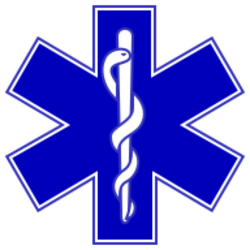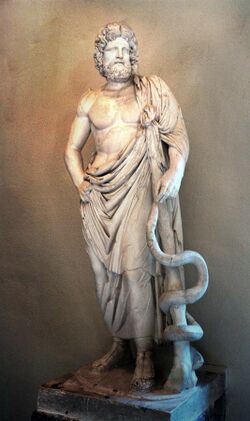Rod of Asclepius

In Greek mythology, the Rod of Asclepius (⚕; Ancient Greek:, Rhábdos toû Asklēpioû, sometimes also spelled Asklepios), also known as the Staff of Aesculapius and as the asklepian,[1] is a serpent-entwined rod wielded by the Greek god Asclepius, a deity associated with healing and medicine. In modern times, it is the predominant symbol for medicine and health care, although it is sometimes confused with the similar caduceus, which has two snakes and a pair of wings.[1]
Greek mythology and Greek society

The Rod of Asclepius takes its name from the Greek god Asclepius, a deity associated with healing and medicinal arts in ancient Greek religion and mythology. Asclepius' attributes, the snake and the staff, sometimes depicted separately in antiquity, are combined in this symbol.[2]
The most famous temple of Asclepius was at Epidaurus in north-eastern Peloponnese. Another famous healing temple (or asclepeion) was located on the island of Kos, where Hippocrates, the legendary "father of medicine", may have begun his career. Other asclepieia were situated in Trikala, Gortys (Arcadia), and Pergamum in Asia.
In honour of Asclepius, a particular type of non-venomous snake was often used in healing rituals, and these snakes – the Aesculapian snakes – crawled around freely on the floor in dormitories where the sick and injured slept. These snakes were introduced at the founding of each new temple of Asclepius throughout the classical world. From about 300 BCE onwards, the cult of Asclepius grew very popular and pilgrims flocked to his healing temples (Asclepieia) to be cured of their ills. Ritual purification would be followed by offerings or sacrifices to the god (according to means), and the supplicant would then spend the night in the holiest part of the sanctuary – the abaton (or adyton). Any dreams or visions would be reported to a priest who would prescribe the appropriate therapy by a process of interpretation.[3] Some healing temples also used sacred dogs to lick the wounds of sick petitioners.[4]
The original Hippocratic Oath began with the invocation "I swear by Apollo the Healer and by Asclepius and by Hygieia and Panacea and by all the gods ..."[4]
The serpent and the staff appear to have been separate symbols that were combined at some point in the development of the Asclepian cult.[5] The significance of the serpent has been interpreted in many ways; sometimes the shedding of skin and renewal is emphasized as symbolizing rejuvenation,[6] while other assessments center on the serpent as a symbol that unites and expresses the dual nature of the work of the Apothecary Physician, who deals with life and death, sickness and health.[7] The ambiguity of the serpent as a symbol, and the contradictions it is thought to represent, reflect the ambiguity of the use of drugs,[8] which can help or harm, as reflected in the meaning of the term pharmakon, which meant "drug", "medicine", and "poison" in ancient Greek.[9] However the word may become less ambiguous when "medicine" is understood as something that heals the one taking it because it poisons that which afflicts it, meaning medicine is designed to kill or drive away something and any healing happens as a result of that thing being gone, not as a direct effect of "medicine". Products deriving from the bodies of snakes were known to have medicinal properties in ancient times, and in ancient Greece, at least some were aware that snake venom that might be fatal if it entered the bloodstream could often be imbibed. Snake venom appears to have been 'prescribed' in some cases as a form of therapy.[10]
The staff has also been variously interpreted. One view is that it, like the serpent, "conveyed notions of resurrection and healing", while another (not necessarily incompatible) is that the staff was a walking stick associated with itinerant physicians.[11] Cornutus, a Greek philosopher probably active in the first century CE, in the Theologiae Graecae Compendium (Ch. 33) offers a view of the significance of both snake and staff:
Asclepius derived his name from healing soothingly and from deferring the withering that comes with death. For this reason, therefore, they give him a serpent as an attribute, indicating that those who avail themselves of medical science undergo a process similar to the serpent in that they, as it were, grow young again after illnesses and slough off old age; also because the serpent is a sign of attention, much of which is required in medical treatments. The staff also seems to be a symbol of some similar thing. For by means of this it is set before our minds that unless we are supported by such inventions as these, in so far as falling continually into sickness is concerned, stumbling along we would fall even sooner than necessary.[12]
In any case, the two symbols certainly merged in antiquity as representations of the snake coiled about the staff are common. It has been claimed that the snake wrapped around the staff was a species of rat snake, Elaphe longissima, the Aesculapian snake.[13]
Egypt
Depictions of one or two staffs with winding snake(s) are known from bronze age Egypt, such as for example the famous 13th century BCE relief depicting Thoth giving life to the deceased Seti I in the temple of Abydos. Thoth, master of the underworld but also one of half a dozen egyptian gods involved in medicine, holds two staves in his left hand. Each staff has a winding cobra around it, with each snake wearing a miniature royal headdress of respectively the upper versus lower halves of Egypt, while raising its upper body in typical uraeus posture with splayed hood.
A biblical equivalent
In the biblical Book of Numbers and Books of Kings, the nehushtan (Hebrew: נחשתן nəḥuštān or נחש הנחושת) was a brass or bronze serpent on a pole that God told Moses to erect, saying that anyone who saw it would be protected from dying from the bites of the "fiery serpents" that God had sent to punish them for speaking against him and Moses.[14][15] The image of a snake wrapped around a staff or a dagger is common in Jewish and modern-day Israeli symbols of medicine, with origins often attributed to the nehushtan's healing powers.[1]
Confusion with the caduceus
Unicode
 | |
|---|---|
Rod of Asclepius | |
| In Unicode | U+2695 ⚕ STAFF OF AESCULAPIUS (HTML ⚕) |
| Related | |
| See also | U+269A ⚚ STAFF OF HERMES |
A symbol ⟨⚕⟩ for the rod of Asclepius has a code point in the Miscellaneous Symbols table of the Unicode Standard.
Modern use

A number of organizations and services use the rod of Asclepius as their logo, or part of their logo. These include:
Asia
Africa
- Kenya Medical Research Institute
- Kenya Medical Training College
- Nigerian Medical Association
- South African Medical Research Council former coat of arms
- South African Military Health Service
South Pacific
- Australian Medical Association
- Australian Medical Students' Association
- Medical Council of New Zealand
- Royal New Zealand Army Medical Corps
- Royal Australian Army Medical Corps
Canada
- Alberta Medical Association
- Canadian Association of Physicians for the Environment
- Canadian Dental Association
- Canadian Medical Association
- College of Physicians and Surgeons of Manitoba
- Medical Council of Canada
- Ottawa Paramedic Service
- Paramedic Association of Canada
- Royal Canadian Medical Service
- Royal College of Physicians and Surgeons of Canada
Europe
United States
Worldwide
- Medical Protection Society
- Star of Life, symbol of emergency medical services
- World Health Organization
Variation
In Russia, the emblem of Main Directorate for Drugs Control features a variation with a sword and a snake on the shield.
See also
- Aaron's rod
- Bowl of Hygieia – Symbol of pharmacy
- Chakra
- Nāga
- Nehushtan
- Ningishzida
- Phurba
References
- ↑ 1.0 1.1 Wilcox, Robert A; Whitham, Emma M (15 April 2003). "The symbol of modern medicine: why one snake is more than two". Annals of Internal Medicine 138 (8): 673–7. doi:10.7326/0003-4819-138-8-200304150-00016. PMID 12693891. http://www.annals.org/cgi/content/full/138/8/673. Retrieved 2007-06-15.
- ↑ See for example Pausanias, Description of Greece 2.26.1–28.1 (here translated by Jones) 2nd A.D.: "The image of Asklepios is, in size, half as big as Zeus Olympios at Athens, and is made of ivory and gold. An inscription tells us that the artist was Thrasymedes, a Parian, son of Arignotos. The god is sitting on a seat grasping a staff; the other hand he is holding above the head of the serpent."
- ↑ Sigerist. Chapter 3, Religious medicine: Asclepius and his cult, p. 63ff.
- ↑ 4.0 4.1 Farnell, Chapter 10, "The Cult of Asklepios" (pp. 234–279)
- ↑ Stephen Lock, John M. Last, George Dunea, The Oxford Illustrated Companion To Medicine, 2001, p261 "In early statues of Asclepius the rod and serpent were represented separately."
- ↑ "Asklepios' reptile was a healing creature: in ancient mythology the snake, whose skin was shed and rejuvenated, symbolized eternity and restoration of life and health" Albert R. Jonsen, The New Medicine and the Old Ethics, Harvard University Press, 1990, p122; this interpretation was current in Antiquity, as can be seen in an account of Apollodorus: "your marvel at the serpent curling around him and say that it is the symbol of the healing art, because just as the serpent sloughs the skin of old age, so the medical art releases from illness." (in E. Edelstein and L. Edelstein (eds.), Asclepius: A Collection and Interpretation of the Testimonies, Baltimore, 1945, p12)
- ↑ "[...] the ancient conception of the serpent as the embodiment of the mystery of one absolute life of the earth, which entails a continual dying and resurrection [...] the combination of corruption and salvation, of darkness and light, of good and evil in the Asklepian symbol." Jan Schouten, The Rod and Serpent of Asklepios, Symbol of Medicine, 1967, p2
- ↑ Albert R. Jonsen, The New Medicine and the Old Ethics, Harvard University Press, 1990, p122-123
- ↑ Henry E. Sigerist, A History of Medicine, Oxford University Press, 1987, p27-28
- ↑ James A. Kelhoffer, Miracle and Mission, Mohr Siebeck, 2000, p438-439 "[...] it was known, at least by some people in antiquity, that a snake's venom is not harmful if imbibed, but rather only if it enters directly into a person's blood stream. For example, the first-century CE historian Lucan writes that the younger Cato, when leading his troops through Libya during the Roman Civil War, informed his men about this very point [...] 'The poison of snakes is only deadly when mixed with the blood; their venom is in their bite, and they threaten death with their fangs. There is no death in the cup.'" He also mentions an account of Cornelius Celsus (first century CE) "'For a serpent's poison, like certain hunter's poisons..., does no harm when swallowed, but only in a wound'". "Likewise, Galen relates a rather peculiar healing by Asclepius involving viper's venom. The god appeared to a wealthy man in Pergamum and prescribed 'that he should drink every day of the drug produced from the vipers and should anoint the body from the outside.' [...] The elder Philostratus describes a similar practice of 'the wise Asclepiads,' who 'heal the bites of venomous creatures... using the virus itself as a cure of many diseases.'"
- ↑ Andre Menez, The Subtle Beast, Snakes From Myth to Medicine, 2003, p14
- ↑ Emma J. Edelstein; Ludwig Edelstein (27 February 1998). Asclepius: Collection and Interpretation of the Testimonies. Baltimore: Johns Hopkins University Press. p. 13. ISBN 0801857694.
- ↑ Gerald David Hart, Martin St. J. Forrest, Asclepius: The God of Medicine, 2000, p42
- ↑ Numbers 21:8
- ↑ 2 Kings 18:4
External links
no:Asklepios#Asklepiosstaven
 |
